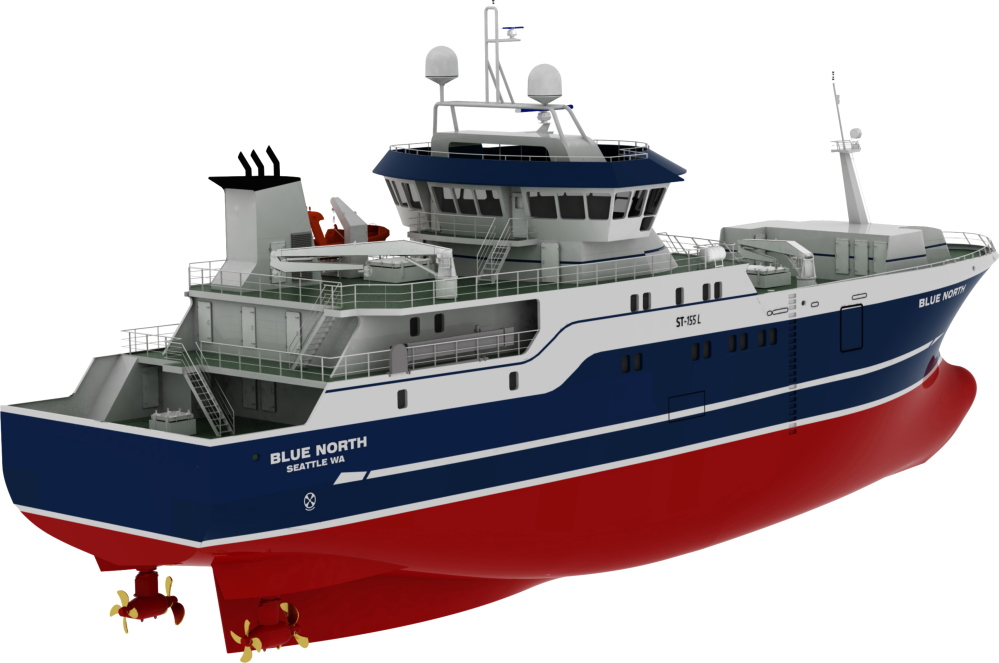ANACORTES, Wash. — Few professions are as deadly as commercial fishing on the Bering Sea.
Crews face rogue waves and frigid gales that toss around heavy machines and cause vessels to pitch, yaw and roll on turbulent waters. The dangers are so constant that they’ve been made lore on the long-running cable show “Deadliest Catch.”
Over the years, efforts to keep crew members safe have taken many forms, from changing the culture among fishermen to equipping them with emergency gear such as survival suits that can help them survive the icy waters longer.
The latest proposed solution is being built in a dry dock north of Seattle: a $35 million, 190-foot vessel that would enable fishermen to work behind the safety of the hull, rather than out on the deck amid the dangerous wind and waves.
The ship, commissioned by Seattle-based Blue North Fisheries, represents the culmination of efforts to keep fishermen safe, said Chris Phillips, managing editor of Fishermen’s News, an industry publication.
“If he’s out there standing in the elements in 15-degree weather and 15-foot waves crashing on the deck, he’s not very happy,” Phillips said. “But if he’s in a well-lit and heated space, he’s a lot happier.”
According to federal statistics, 32 fishermen died on the job in 2012, a drop from 42 the year before. Still, the profession remains one of the nation’s deadliest with a 2012 fatality rate of 117 per 100,000 workers, compared to 17 for construction crews.
Jennifer Lincoln, an injury epidemiologist with the National Institute for Occupational Safety Health, said the vessel’s design represents an attempt to avoid the hazards completely. “It’s a big deal to engineer out the occupational hazard from the beginning,” she said.
Currently, a crew member is at risk while the long-line is being reeled in. Usually a crew member has to hook the fish being reeled in to process them. That requires standing out on the deck. And sometimes crew members get tossed into the water.
In Alaska, for example, 158 fishermen died between 2000 and 2012; 49 of those fatalities were crew getting tossed overboard, Lincoln said.
Under construction in Anacortes, near Puget Sound, Blue North Fisheries’ new flagship vessel is due to hit waters in late 2014. It will be the first of its kind for U.S. commercial fishing – a similar model is already in use in Norway.
The long-lines of hooked cod will be pulled from under the boat. The opening, described as an elevator shaft by Blue North Fisheries co-founder Patrick Burns, is in the bottom-center of the vessel – a so-called moon pool. The opening goes up two stories to a platform where the crew will reel in the long-line.
The design will work for bringing in cod, but not for crab, the prize haul on the Discovery Channel’s “Deadliest Catch,” which has been on the air since 2005, observers said. From there, the fish will move on to the process line.
Beyond keeping fishermen away from the waves, the vessel is being designed to act as a floating processing plant. Blue North’s goal is to process more than 90 percent of each fish, leaving little to waste. The previous average was about 70 percent, the company said.
In years past, crews raced against each other in a deadly derby, trying to catch as many fish as possible under a tight deadline. Now, cod hauls are regulated under a quota system, which has relaxed time pressures on the crews.
Coast Guard officials also check to make sure vessels weren’t overloaded. “You’re not trying to catch as many fish as you can,” said Kenny Down, Blue North’s CEO.
“You’re trying to do the most you can with the fish you caught,” he said.
The design aims to change the way fishing is done in the Bering Sea.
“Nobody knows if it will catch on, but I think it deserves a chance,” Phillips said. “I suspect when the Blue North is out and fishing, the rest of the industry will want to follow suit.”
Send questions/comments to the editors.



Success. Please wait for the page to reload. If the page does not reload within 5 seconds, please refresh the page.
Enter your email and password to access comments.
Hi, to comment on stories you must . This profile is in addition to your subscription and website login.
Already have a commenting profile? .
Invalid username/password.
Please check your email to confirm and complete your registration.
Only subscribers are eligible to post comments. Please subscribe or login first for digital access. Here’s why.
Use the form below to reset your password. When you've submitted your account email, we will send an email with a reset code.